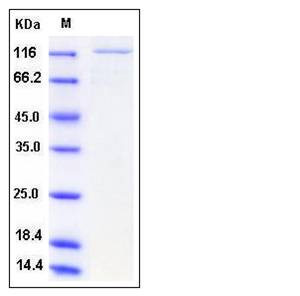Human MAP4K5 / MEKKK5 Protein (His & GST Tag)
GCKR,KHS,KHS1,MAPKKKK5
- 100ug (NPP2331) Please inquiry
| Catalog Number | P11773-H20B |
|---|---|
| Organism Species | Human |
| Host | Baculovirus-Insect Cells |
| Synonyms | GCKR,KHS,KHS1,MAPKKKK5 |
| Molecular Weight | The recombinant human MAP4K5/GST chimera consists of 1083 amino acids and has a calculated molecular mass of 123 kDa. It migrates as an approximately 116 kDa band in SDS-PAGE under reducing conditions. |
| predicted N | Met |
| SDS-PAGE |  |
| Purity | > 82 % as determined by SDS-PAGE |
| Protein Construction | A DNA sequence encoding the human MAP4K5 (NP_006566.2) (Met 1-Tyr 846) was fused with the N-terminal polyhistidine-tagged GST tag at the N-terminus. |
| Bio-activity | Kinase activity untested |
| Research Area | Signaling |Signal Transduction |Protein Kinase |Intracellular Kinase |MAP4K (Mitogen-Activated Protein Kinase Kinase Kinase Kinase) |
| Formulation | Supplied as sterile 50mM Tris, 100mM NaCl, 0.5mM PMSF, 0.5mM TCEP, pH 8.5 1. Normally 5 % - 8 % trehalose, mannitol and 0.01% Tween80 are added as protectants before lyophilization. Specific concentrations are included in the hardcopy of COA. |
| Background | Mitogen-activated protein kinase kinase kinase kinase 5, also known as Kinase homologous to SPS1/STE20, MAPK/ERK kinase kinase kinase 5, MEK kinase kinase 5 and MAP4K5, is a cytoplasm protein which belongs to the protein kinase superfamily, STE Ser/Thr protein kinase family and STE20 subfamily. MAP4K5 is ubiquitously expressed in all tissues examined, with high levels in the ovary, testis and prostate. It contains one CNH domain and one protein kinase domain. MAP4K5 is highly similar to yeast SPS1/STE20 kinase. Yeast SPS1/STE20 functions near the beginning of the MAP kinase signal cascades that is essential for yeast pheromone response. MAP4K5 has been shown to interact with CRKL and TRAF2. This kinase was shown to activate Jun kinase in mammalian cells. MAP4K5 is an early component of MAP kinase signal cascades. It may play a role in the response to environmental stress. MAP4K5 appears to act upstream of the JUN N-terminal pathway. |
| Reference |
